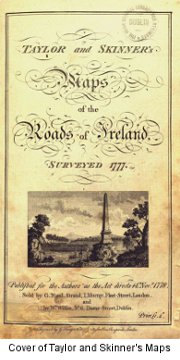Journal Volume 3 2000
Greystones in Cartographic Sources: the Wicklow County Maps(continued/1)
Jacob Nevill's Map
Over one hundred years were to elapse before the next county survey, by Jacob Nevill in 1760. Nevill was a Dublin mathematician and cartographer. His mapping commission for the County Wicklow Grand Jury was the first true county map to show fine detail. It is a document of great interest.
The map’s main purpose was its use by the Established Church and other clergy, county officials, military officers and the members of the Grand Jury, which were the forerunners of county councils. Detail on the map tend to concentrate on roads and gentlemen's 'seats', with the names of the more prominent landowners recorded. Churches ruined and in service, Protestant and Catholic were included, reflecting the then preoccupation with religion and tithe collection. Water mills, graveyards and land usage i.e. whether it was in pasture or fallow was shown in many instances.
In all, Nevill’s 1760 map is a valuable record of a Wicklow as it was 240 years ago. The name "The Grey-Stones" is shown applied to a headland, and this is one of the first, if not the first recording of the name. While no access to the headland is depicted on the map, a scattered fishing community was probably already established, but as these were not the things Nevill choose to record, there is no indication on the map of any habitations of, as they were described "the Lower Orders".
The hub of the populated area was still centred on Delgany. The local road system was well defined, as it should be, for this was one of the main purposes of the map. Lord Meath's extensive deer-park is given prominence, extending down as far as Templecarrig. A corn mill is located at Killincarrig. The then secondary coach road is recorded as 'Down Glen' road. The substantial houses of Templecarrig, Coolegad, Kindlestown and Rathdown are given prominence. The famed mansion later to become known as "Bellevue" is still recorded under its old name Ballydonagh as it was known when under the ownership of the Dean of St Patrick's, (not dean Jonathan Swift, however, who did not reside in this part of the country).
Jacob Nevill's map does not give any indication to the reality of the largely hidden population of labours, fishermen, artisans, farm workers, gardeners and their families who lived in small vernacular cabins scattered all over the landscape. Nor does it give any indication of the embryonic tourist industry, which even then was beginning to make itself felt in the scenic areas around Bellevue and the Glen of the Downs. A good replica of Nevill's Wicklow map is included in the end paper of Wicklow History and Society published in 1994 and available in the local library.
labours, fishermen, artisans, farm workers, gardeners and their families who lived in small vernacular cabins scattered all over the landscape. Nor does it give any indication of the embryonic tourist industry, which even then was beginning to make itself felt in the scenic areas around Bellevue and the Glen of the Downs. A good replica of Nevill's Wicklow map is included in the end paper of Wicklow History and Society published in 1994 and available in the local library.
Taylor and Skinner's Maps
Taylor and Skinner's "Maps of the Roads of Ireland" published in 1778 continued to focus exclusively on 'gentlemen's seats' and on roads. It was best used in conjunction with another publication, "The Post Chaise Companion", which described in words the landscape visible from the coach. Greystones is not shown on the T and S map, but the rising ascendancy of Bellevue and the La Touche family is marked. Other notable residences of the area are named along with their owners, Wilsons of Kindlestown, Scotts of Ballygannon, Edwards of Charlesland, and O'Brien of Mountemple. Miss Moore of Rathdown is the rare notice of a female proprietor in what was then a very male dominated society. Half a dozen residences within 6 miles of Greystones were owned or rented by military officers. This reflected a trend when half pay officers could live twice as cheaply in Ireland as in England; thus there was a Captain Tarrent in Rathdown, a Captain Ransoms in Templecarrig and a cluster of military retirees centred on Newtownmountkennedy. Delgany's old Church of Ireland was depicted simply because it was a coaching landmark and mileage reference point.
Abraham Nevill issued a revised Grand Jury map in 1798. It contains no new detail on the Greystones area. The usual imagery for the grand houses of the area is included and Bellevue is mentioned by name.
